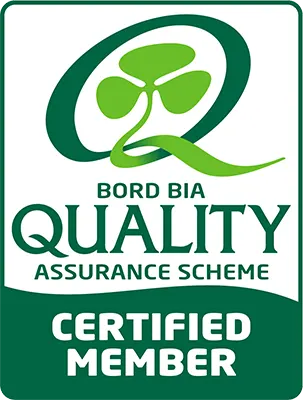Spring turnout should bring opportunity, not setbacks. But for many dairy farmers, the grazing season brings a familiar challenge, falling butterfat levels, even as yields rise. This drop in milk quality isn’t just frustrating; it hits hard where it matters most: the bottom line.
Fortunately, with the right feed strategy and nutritional support, you can protect butterfat levels, improve body condition, and safeguard herd fertility — all while making the most of spring grass.
The Spring Butterfat Drop – Why It Happens
As cows transition from silage-based winter diets to lush, fast-growing spring grass, their nutritional balance shifts dramatically. The result? A drop in butterfat percentage, reduced solids, and lost bonuses, even as total litres increase.
Three key changes occur:
- Fresh grass is low in effective fibre, essential for rumen health.
- Rumen pH drops, affecting fermentation and microbial balance.
- Butterfat synthesis declines, leading to milk fat depression.
This nutritional imbalance reduces the cow’s ability to convert grass into high-quality milk, affecting not only milk price but also herd health and fertility.
Real Financial Impact — Small Drops, Big Losses
Milk pricing structures reward solids, not just litres. That means:
A cow producing 36 litres at 4.0% butterfat earns about the same as one producing 35 litres at 4.25%.
Now apply that to a 100-cow herd — that 0.25% difference in butterfat could mean hundreds of euros lost every month.
And when bonuses are tied to thresholds, even a small dip can push milk below the cutoff. That’s money off the table, despite the same or more effort on-farm.
The Significance of Buffer Feeding
To counteract the challenges associated with spring grazing, including low butterfat levels, strategic buffer feeding becomes imperative. Buffer feeding is essential in the strategic management of a dairy herd, playing a pivotal role in maintaining overall health and elevating milk quality.
The significance of buffer feeding lies in its ability to counterbalance variations in the nutrient composition of available forages, ensuring a consistent and well-rounded diet for dairy cows. By providing additional nutrients during periods of nutritional imbalance, buffer feeding not only supports optimal milk production but also safeguards against milk fat depression, making it an essential component of a comprehensive dairy management strategy.
Furthermore, the key to successful buffer feeding lies not only in the choice of additives but also in their strategic integration into the overall feeding regimen. Dairy farmers are adopting innovative approaches to seamlessly incorporate buffer feeding into their daily practices, ensuring sustained butterfat levels and overall herd health.
Feed Smarter: Strategies to Protect Butterfat and Profit
Many dairy herds experience a drop in milk fat during turnout and early grazing, with typical losses of 0.5% between three to nine weeks post-turnout. The biggest risk comes from young, leafy spring grass, which is low in fibre, high in sugars, and contains 50% more unsaturated fat than winter rations. This combination leads to acidic rumen conditions and increased production of CLA — a compound that disrupts milk fat synthesis. Good management is key to protecting butterfat during this period. Specialist Nutrition supports farmers with practical feed solutions that complement spring grass and stabilise milk quality. Here’s how.
1. Cafre Excel Protected Fat – Energy Where It’s Needed Most
One of the simplest and most effective ways to support milk production, fertility, and body condition during high-grass intakes is to increase the energy density of the diet.
Cafre Excel Protected Fat delivers:
- Rumen-protected energy supports yield without upsetting rumen balance
- C16 and C18 fatty acids – the essential building blocks of milk fat synthesis
- Improved fertility, better condition scores, and reduced risk of acidosis
- Free-flowing, easy-to-feed flake – ready to mix into rations or top-dress
With over 2.25x the energy of protein or carbs, protected fat is a proven tool for lifting butterfat % and improving the energy profile of the entire diet.
2. Silage and Straw – Rebuilding Fibre for the Rumen
Fresh grass digests quickly and lacks structural fibre. This limits chewing and reduces saliva production, which is essential to buffer rumen pH.
Feeding silage or chopped straw alongside pasture provides:
- Improved rumen function
- Better fibre digestion
- Reduced risk of SARA (Sub-Acute Ruminal Acidosis)
- A buffer against milk fat depression
3. Moist Feeds – Energy and Structure in One
Moist feeds like brewers’ grains and pressed beet pulp are fibre-rich and highly palatable. They can help to:
- Increase dry matter intake
- Slow digestion for better fermentation
- Help maintain consistent butterfat levels
They’re especially useful for spring-calving herds with high energy demand and limited condition reserves.
4. High-Energy Concentrates – Balance Rapid Grass Digestion
Feeds such as maize meal and beet pulp complement the high protein and low fibre of spring grass. These help:
- Stabilise energy release in the rumen
- Reduce variability in milk quality
- Support solids production for better processor bonuses
5. Mineral & Protein Balancers – Closing the Nutritional Gaps
Even a great forage plan needs the right mineral support. Specialist Nutrition’s tailored balancer packages ensure:
- No deficiencies that could compromise fertility or butterfat
- Improved efficiency of the whole ration
- Better return on feed investment
6. Rumen Buffering and Additive Support
Adding rumen buffers and milk fat enhancers to the diet is a proactive way to prevent milk fat depression during high-risk periods, such as when cows are grazing on young, high-oil spring grass. Specialised additives, like Equaliser Cream, help stabilise rumen pH and reduce the negative impact of excess oil in fresh grass on milk fat levels. Unlike traditional buffering agents, Equaliser Cream addresses both rumen acidity and the disruptive effect of high dietary oil levels.
Equaliser Cream:
- Acts as a dual-function buffer, replacing the need for separate yeasts or C16 fat supplementation
- Stabilises rumen pH and improves digestion
- Reduces the impact of CLA on milk fat synthesis
- Offers cost-effective performance compared to traditional palm-based fat products
Why Butterfat Is More Than a Number
Butterfat percentage isn’t just a processor metric — it’s a direct reflection of rumen health and diet effectiveness. When butterfat drops:
- Digestive efficiency suffers
- Fertility declines
- Milk price takes a hit
And in high-output herds, small issues can snowball into long-term performance and profit challenges.
A Smarter Feeding Strategy Starts with On-Farm Data
At Specialist Nutrition, we don’t believe in guesswork. Our on-farm support includes:
- Forage analysis to understand what your grass is providing
- Ration formulation tailored to herd stage and milk targets
- Seasonal reviews to adapt as conditions and grass quality change
Don’t Let Spring Undermine Your Margins
The spring flush doesn’t have to come at the expense of butterfat or profit. With the right nutritional tools — like Goldenflake Protected Fat, structural fibre, and energy-dense moist feeds — you can protect milk quality, improve condition, and safeguard herd fertility. For advice tailored to your farm, get in touch with Specialist Nutrition today.





